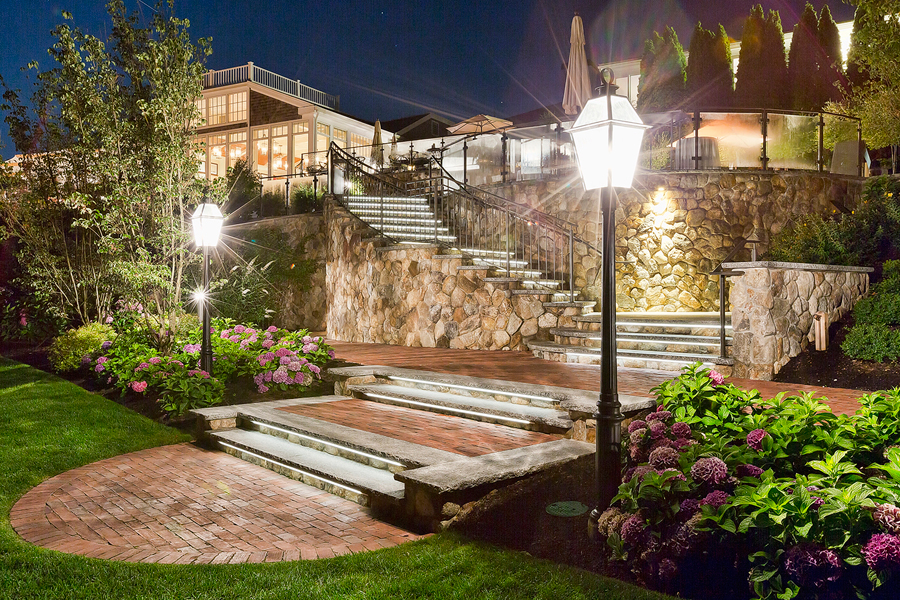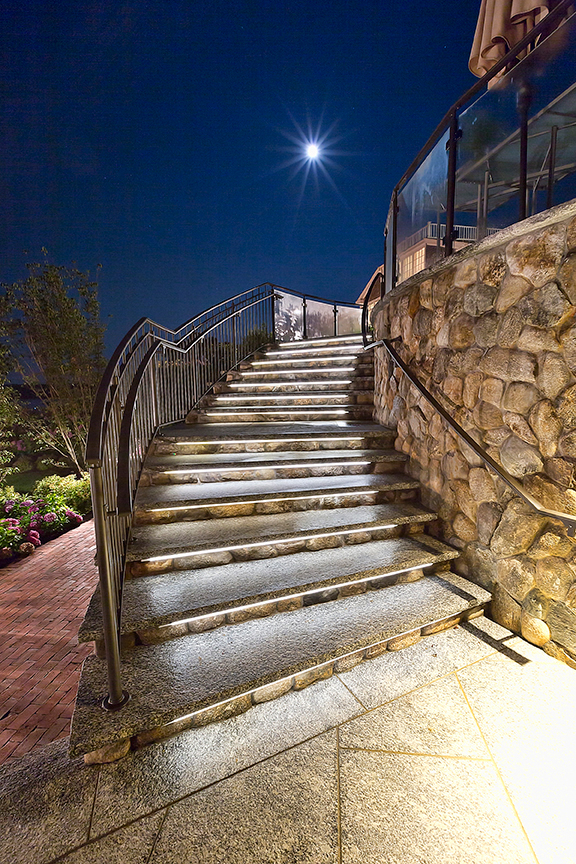April 16, 2015 | Anonymous

Wequassett Inn & Resort in Harwich, MA (above)
The experts at Schumacher Companies have taken the complexity out of installing effective and beautiful landscape lighting on your property. Below, they elaborate on the do's and don'ts of landscape lighting, and how to choose the right lighting and location to make the most of your yard, gardens, and stone pathways or staircases.
Landscape lighting involves more than just focusing lights on trees or along walkways. At its most basic this may be true, but a well-designed system provides benefits far beyond its immediate visual impact. When done well, landscape lighting also establishes mood as well as a measure of safety and security. Bright lights that minimize shadows on paths and around entryways enhances safety, of course. But atmosphere and mood are formed equally by what is in shadow, what is in light, and the interplay between the two. For example, combining wide, diffuse lights with soft down-lighting creates layers that evoke a relaxed mood. Spotlights, on the other hand, when focused on unique features, create a contrast that evokes a sense of drama. Obviously, these are simple examples. In contrast, your home’s landscape lighting plan will be much more complex. For these reasons, we strongly suggest that you hire a professional to design and install your landscape lighting. Whether you hire a professional, however, or plan to do your own install, here are some do’s and don’ts to keep in mind as you move forward with your project.

Wequassett Inn & Resort in Harwich, MA (above)
Do
Do: Use a variety of beam intensities throughout your property. Using the same bright lights in all your fixtures can ruin the sense of texture and depth you are trying to achieve and make your landscape look flat.
Do: Think about shadow as well as light. Atmosphere is established through the interplay of light and shadow. If you have garden walls, you might consider using well lights placed at the base to shine up. The play of light and shadow on the wall's face will highlight the stone's texture. And silhouetting a tree against a fence, home facade, or even the surface of a pool adds depth to an otherwise flat surface.
Do: Use enough fixtures to light your property. Many people try to save money by skimping on the amount of fixtures and compensating for this by increasing the brightness of the bulbs they use. This does nothing more than create alternating areas of extreme bright and dark. If you need to save money, install your system in phases, concentrating around the house to begin. This will ensure that each area achieves the look you desire, and it makes the installation easier (and less costly!), too.
Do: Bathe not only a tree's canopy in light, but also its trunk. Lighting only the canopy makes the tree look like a floating cloud of leaves creating a disconcerting ghostly effect.
Do: Use LED lighting. Today's newer LED-based systems use 60-70% less energy than their halogen counterparts of just five years ago, and LED bulbs last ten years or more. Furthermore, you can now find LED bulbs that reflect the same soft warm whites of halogen bulbs.
Don’t
Don’t: Light only walkways, patios, and trees. Doing so isolates these elements and surrounds them with inky darkness, which can be disconcerting if you're trying to relax on your patio but can't see beyond the darkness at its edge. This can be corrected by placing lights at the edge of the property in plant beds and trees. Doing so helps ground these elements within the larger landscape design and provides a sense of depth.
Don’t: Light pathways and staircases the same way. Pathways are flat surfaces that won't create shadows. Stairs, alternatively, will show shadows with even the smallest amount of light. For example, lighting a staircase by placing lights at the top and shining them down makes the bottom stairs and landing extremely hard to see. For a narrow staircase, a single light on each riser is fine, but if the stair is wider, you may need to place multiple lights on each.
Don’t: Use bullet lights for every aspect of your home's exterior. Bullet lights are versatile and can be fitted with different bulbs and beams, but they are still essentially spotlights. When lighting your home's exterior, limit bullet lights to corners and architectural details. Use softer wash lights for facades.
Don’t: Under-light landscaping features. Using one light to illuminate arbors, lawn statues, or water features creates harsh shadows. Use two lights spaced sufficiently apart to avoid this mistake. But be careful to keep your bulb intensities low so you don't wash the feature out.
Don’t: Use solar lights. They produce minimal light and are weather-dependent (no sun - no light). In addition, the quality of the fixtures is lacking. If you are environmentally-conscious, install low-voltage LED lighting which uses 1/10th the energy of traditional halogen-based systems.


Add new comment